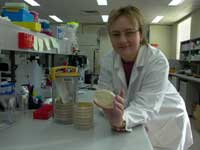An advanced microbiological technique that provides a “snapshot” of the bacterial population in the chicken’s gut is being used to determine the right balance of bacterial species for the bird’s gut health.
The research behind the development is part of a Poultry CRC strategy to enable the fine tuning of diets through a better understanding of the bacterial population in the chicken’s gut.
According to the Poultry CRC’s Commercialisation Manager, Lloyd Thomson, poultry companies, through the diligent work of their nutritionalists, have attained excellent feed conversion ratios with conventional nutrition science.
“This line of research seeks to further enhance bird performance through the optimal utilisation of the feed by the gut bacteria,” said Lloyd. “In effect, to fine tune diets by taking the microbiology into account.”
“Gut microbiology and its role in animal health have become increasingly important,” said Poultry CRC Project Leader, SARDI’s Valeria Torok, “particularly now that the use of antibiotics in animal feeds to manage health and promote growth has been banned in the European Union and is being questioned by consumers in other countries. We have shown that gut microflora composition is correlated with performance, implying the presence and/or absence of specific organisms are contributing to improved productivity.”
“Furthermore, litter type plays a role in poultry gut microflora development. This implies that the choice of litter material is an important factor in modulating the gut microflora.”
Valeria has completed the first project, which established that the microbiological technique does work, and is now leading a follow-up Poultry CRC project to identify bacterial components associated with early establishment of a healthy gut microflora, which may be used to promote beneficial life-long colonisation.


